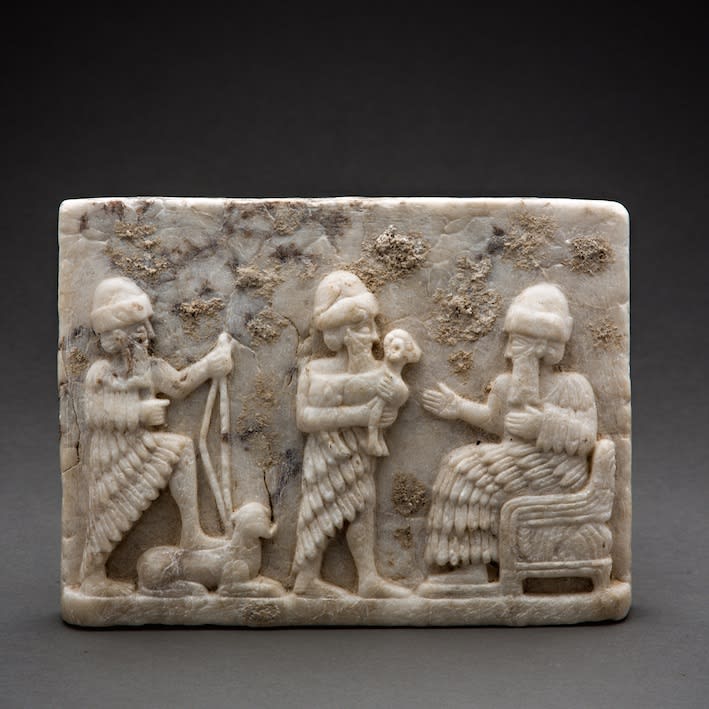Sumerian relief plaque in calcite alabaster, 3000 BCE - 2000 BCE
Alabaster
23.9 x 18.8 cm
9 3/8 x 7 3/8 in
9 3/8 x 7 3/8 in
LM.69
A male figure, seated on an elaborate throne and resting his feet upon a stool, is depicted in profile to the left as long bearded, wearing the characteristic headgear for...
A male figure, seated on an elaborate throne and resting his feet upon a stool, is depicted in profile to the left as long bearded, wearing the characteristic headgear for men of all classes and kaunaks, the unisex garment made from sheepskin and worn with the skin turned inside and with tufts ornamented like a toothed-comb over the wool. This type of clothing article was used in the form of a wraparound skirt tied and worn from the waist extending to the knees, covering the body while crossing over the left shoulder, as seen in this case.
The seated figure is in the act of extending both hands towards a standing male figure which is approaching while holding a young ram.
The scene is brought to a well balanced aesthetic conclusion with the figure of a third male, equally bearded and similarly dressed, who is holding with his left a long cross-bow, while posing his left foot on the back of a crouching calf. Sumer was an ancient civilization founded in the Mesopotamian region of the Fertile Crescent, the territory situated between the Tigris and Euphrates rivers. Known for their innovations in language, governance, architecture and the arts, Sumerians are considered by many historians the creators of civilization, as modern humans understand it. Their control of the region lasted for short of 2,000 years, before the Babylonians took charge in 2004 B.C.
The city of Mari was an ancient Semitic city in Syria that flourished as a trade center and hegemonic state between 2900 BC and 1759 BC. Mari is not considered a small settlement that gradually grew, but rather a purposely founded and built new city around 2900 BC, to control the waterways of the Euphrates trade routes that connect the Levant with the Sumerian south, before being abandoned and forgotten during the Hellenistic period.
The name of the city can be traced to Mer, the patron of storms, a male deity of northern Mesopotamia and Syria, who was considered the patron deity of the city. Mari’s discovery in 1933 provided an important insight into the geopolitical map of ancient Mesopotamia and Syria, due to the discovery of more than 25,000 tablets that contained important information about the administration of the state during the second millennium BC and the nature of diplomatic relations between the political entities in the region. They also revealed the wide trading networks which connected areas as far as Afghanistan in Southern Asia and Crete in the Mediterranean region. Low relief sculptures were abundantly and freely used on building walls and in materials less heavy than stone, as independent ornament. The variety of themes and the multitude of figures reveal to the viewer a picture of societies that delighted in refined workmanship in metals and stone and shell, as well as in colorful decoration and intricate pattern.
The seated figure is in the act of extending both hands towards a standing male figure which is approaching while holding a young ram.
The scene is brought to a well balanced aesthetic conclusion with the figure of a third male, equally bearded and similarly dressed, who is holding with his left a long cross-bow, while posing his left foot on the back of a crouching calf. Sumer was an ancient civilization founded in the Mesopotamian region of the Fertile Crescent, the territory situated between the Tigris and Euphrates rivers. Known for their innovations in language, governance, architecture and the arts, Sumerians are considered by many historians the creators of civilization, as modern humans understand it. Their control of the region lasted for short of 2,000 years, before the Babylonians took charge in 2004 B.C.
The city of Mari was an ancient Semitic city in Syria that flourished as a trade center and hegemonic state between 2900 BC and 1759 BC. Mari is not considered a small settlement that gradually grew, but rather a purposely founded and built new city around 2900 BC, to control the waterways of the Euphrates trade routes that connect the Levant with the Sumerian south, before being abandoned and forgotten during the Hellenistic period.
The name of the city can be traced to Mer, the patron of storms, a male deity of northern Mesopotamia and Syria, who was considered the patron deity of the city. Mari’s discovery in 1933 provided an important insight into the geopolitical map of ancient Mesopotamia and Syria, due to the discovery of more than 25,000 tablets that contained important information about the administration of the state during the second millennium BC and the nature of diplomatic relations between the political entities in the region. They also revealed the wide trading networks which connected areas as far as Afghanistan in Southern Asia and Crete in the Mediterranean region. Low relief sculptures were abundantly and freely used on building walls and in materials less heavy than stone, as independent ornament. The variety of themes and the multitude of figures reveal to the viewer a picture of societies that delighted in refined workmanship in metals and stone and shell, as well as in colorful decoration and intricate pattern.



